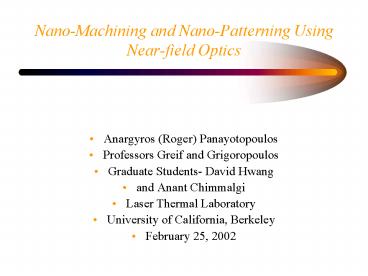NanoMachining and NanoPatterning Using Nearfield Optics PowerPoint PPT Presentation
1 / 31
Title: NanoMachining and NanoPatterning Using Nearfield Optics
1
Nano-Machining and Nano-Patterning Using
Near-field Optics
- Anargyros (Roger) Panayotopoulos
- Professors Greif and Grigoropoulos
- Graduate Students- David Hwang
- and Anant Chimmalgi
- Laser Thermal Laboratory
- University of California, Berkeley
- February 25, 2002
2
Why is Nano-Technology Important?
- Current Feature Size 0.25 microns
- Applications
- Nano-Lithography (Photomask production and
repair) - Nano-Machining
- High density data storage
- Nanophotonic devices
- Fabrication of hybrid systems of molecular
electronics - Micro/nano surgery (Dentistry, Ophthalmology)
- Micro/nano biological technology
3
Methods to Reach Nanometer Resolutions
- Electron Beam Lithography
- X-ray Lithography
- Scanning Tunneling Microscopy (STM)
- Atomic Force Microscope (AFM)
- Scanning Near-field Optical Microscope (NSOM)
- Ultra-fast Laser Ablation (Multi-photon effects)
4
What Differentiates NSOM?
- Complicated
- Mask Dependence
- Preferential Etching
- Conductivity
- NSOM
- Mask-free deposition
- Reliable and controllable
- Metals, oxides, semi-conductors, insulators
- Chemical composition and morphology
- PCVD (Photo-Chemical Vapour Deposition) coupling
5
Far-field and Near-field Optics
- Far-field Optics
- Geometric optics based on traditional optical
element (Lens) - Fails to perform adequately under certain
circumstances - Sub-wavelength apertures
- Deep UV radiation
- Wavelength independence
- Ultra-short pulses
- Near-field optics
- Form of lens-less optics with sub-wavelength
resolution - Independent of the wavelength of light being used
6
Far-field and Near-field Optical Schematics
7
Critical Parameters Defining NSOM
- Concentration of Light Energy
- Nano-metric Dimensions of Light
- Electromagnetic Interactions of Tip
- Enables Deposition of Various Materials
- Photo-decomposition of chemical gases.
- Optical Resolutions Beyond the Diffraction Limit
- Process Limitations
8
NSOM Combinational Techniques
- NSOM Using Optical Fiber Tips
- NSOM/AFM Cantilevered Tips
- NSOM Using Micro-machined Apertures
- NFO-PCVD
9
Experimental Setup of NSOM System
Fiber tip by Nanonics Inc.
NSOM Schematic by DI Inc.
10
NSOM/AFM Cantilever Tip Focusing
SiO2 cantilevered tip (Mitsuoka et al. 2000)
Waveguide tip (Takashi et al.1999)
11
Probe Tip and System Control of NSOM
- Probe Tips
- Receiving/Transmitting Antennas
- Tip Distance Control
- Beam Deflection Method
- Shear Force Measurement
- Piezo-Electric Tuning Fork
- Cantilever Normal Force
Piezo-resistive micro cantilever (Muramatsu et
al. 2000)
12
NSOM Using Optical Fiber Tips
- Force Pulling Fabrication Method
Foil-heater Schematic (above), Tips from one
pulling step (left) (Gallacchi et al. 2000)
13
Optical Fiber Tips by Foil Heating
Heat pulled fiber tips (Gallacchi et al. 2000)
14
Fabrication of Cantilevered Tips
- Etching/Micro-Machining
- E-beam lithography, LPCVD, DRIE
- Fabrication Steps
- Selective etching
- Sacrificial deposit and masking
- Metals core coating
- Apex removal
Fabrication steps for SiO2 tip (Minh et al. 2000)
15
Etched Cantilever Tip Images
Topological image of tip radius (Jung et al. 2000)
Fabrication of Si3N4 cantilever tip (Jung et al.
2000)
16
SEM Micrographs of AFM Tip Profiles
Tip radius (Jung et al. 2000)
17
NFO Using Ultra-fast Laser Ablation
- Extremely Fast Energy Deposition
- Femto/Pico second time scales
- Resulting in Subsequent Material Ablation
- Without thermal heat shocks or mechanical
damaging (ie. Melting, burr formation, cracks)
18
Ablation- Rapid Absorption Process
- Ablation
- Related to direct transmission from solid to
gaseous state without liquid phase - Laser energy absorbed (excitation and ionization
of material) inside electronic subsystem
(lattice) by free electrons by inverse
Bremsstrahlung - Bremsstrahlung- Energy lost by electrons that
appears as energy radiating away from site - Collision momentum transfer to atom, electron KE
losses
19
NFO-PCVD Patterning Method
- Utilizes NFO in vacuum
- Photo-dissociation
NFO-PCVD Schematic (Polonski et al.1999)
20
NFO-PCVD Pattern Processing
- 2 Step Process
- a) Pre-nucleation
- b) Film Growth
NFO-PCVD Process (Polonski et al.1999)
21
NFO-PCVD Pattern Processing
- Near-field/Far-field Exposure
NFO-PCVD Absorption/Decomposition Mechanism
(Ohtsu et al. 2000)
22
NFO-PCVD Patterned Resolutions
Shear-force image (Polonski et al.1999)
23
NSOM Transmission Efficiency
- Efficiency (Transmission Throughput)
- Scattered light power from the aperture/ input
light power - Function of aperture diameter, distance,
polarization - Key Considerations for Higher Efficiencies
- Tip reproducibility
- Reliable distance control and probe handling
- Large refractive index
- Leads to short effective wavelength inside the
probe material resulting in high transmission
effect
24
NSOM Transmission Efficiency of Fiber Tips
- Fiber Material- Glass
- constant optical properties, thus good for
infrared spectroscopy - Intensity strongly dependent on dielectric
properties of tip - Typical Transmissions 10-4 to 10-6
- Possible Solutions to Decrease Propagation Loss
- Multiple tapered probes
- Metal coatings
25
Multi-Tapered Optical Fibers
- Probe configuration Intensity Enhancement
Electric field of tapered fiber tip (left),
Intensity Plots (right) (Nakamura et al. 2000)
26
Transmission Efficiencies of Cantilevered Tips to
Fiber Tips
- Excellent optical efficiency/throughput
- Transmission efficiencies 10-2 to 10-4
- Large NA objectives provide high optical
throughput, but also means shorter working
distance and disturbs optical path - Tip-to-sample Regulation
- Normal force deflections of the cantilever
- Better control, and easier than other techniques
- Flexible and metal coated apertures not damaged
after scanning
27
Probe-to-Probe Intensity Measurement
- Constant Height Mode
- Soft/hard substrate rough estimate
- Probe-to-Probe configuration (Ohtsu et al. 2000)
28
NSOM Intensity Distribution
- Elliptical Profile Distributions
- NFO properties of tip aperture
- Asymmetry of the tip
- Vibrational effects
- Polarization effect
- Intensity Distribution (Lu et al. 2001)
NFO Intensity (Minh et al. 2000)
29
Photo-Chemical Intensity Measurement
- Analyzing Oxidation Region
- 2-D Intensity Distribution Photo-Oxidized
Region - N(x,y) SS I(u,v)O(x-u,y-v) dudv
- O(x,y) I(x,y)
- gtgt N(x,y) SS I(u,v)I(x-u,y-v)dudv
- Contour plot of photo-oxidation region
(right), Cross-sectional plots of intensity
regions (above) (Wei et al. 1996)
30
Polarization Effects on Intensity Transmission
Transmission Effect (Kawashima et al. 2000)
Polarization Effects (Kawashima et al. 2000)
31
Current Research Goals
- Determine Intensity Correlations of
Photosensitive Polymers - Designs for Optimal Tip Configurations
- Parametric Studies of Material Responses
- Studies due to Various Lasers
- Femto/pico second laser, Excimer

